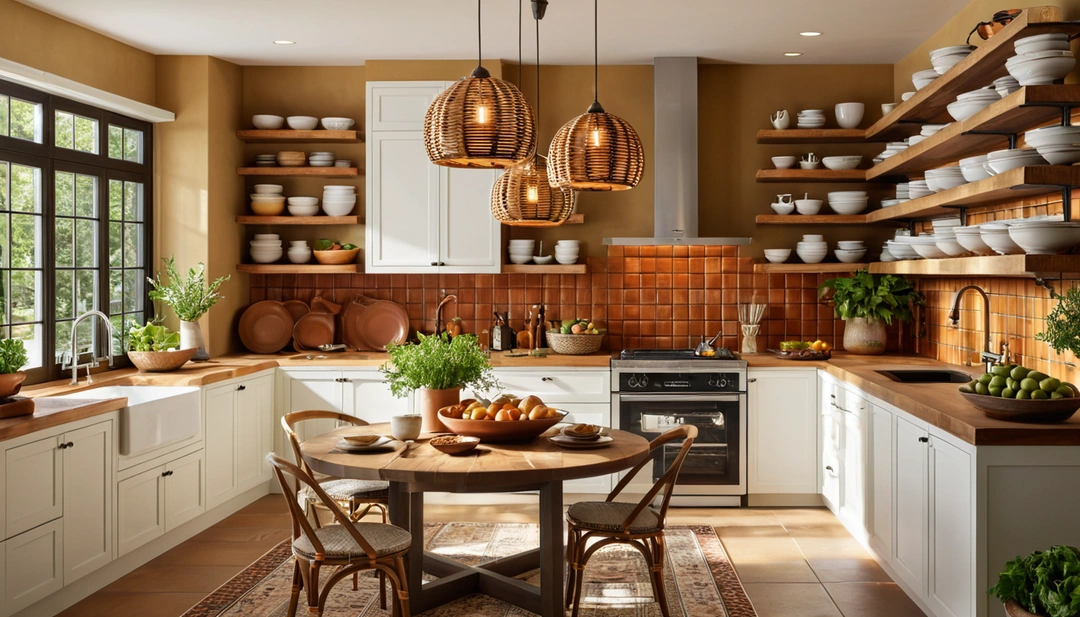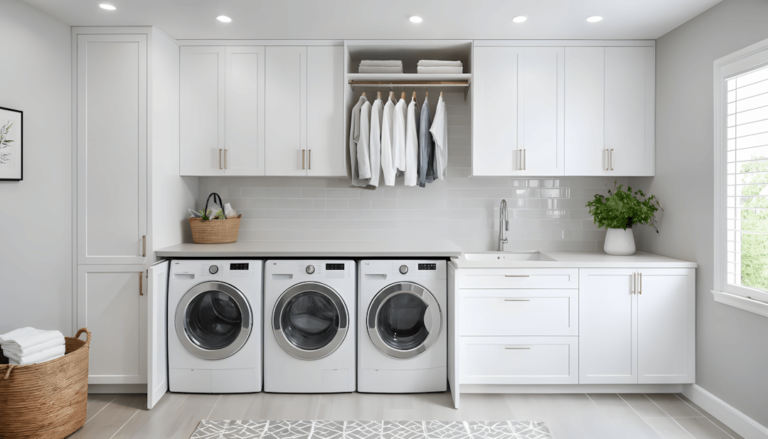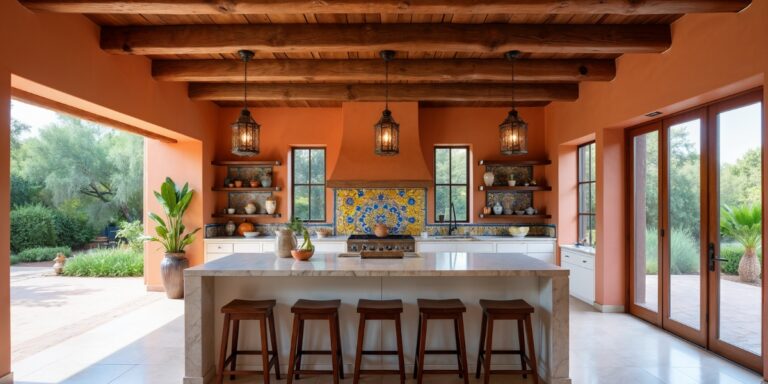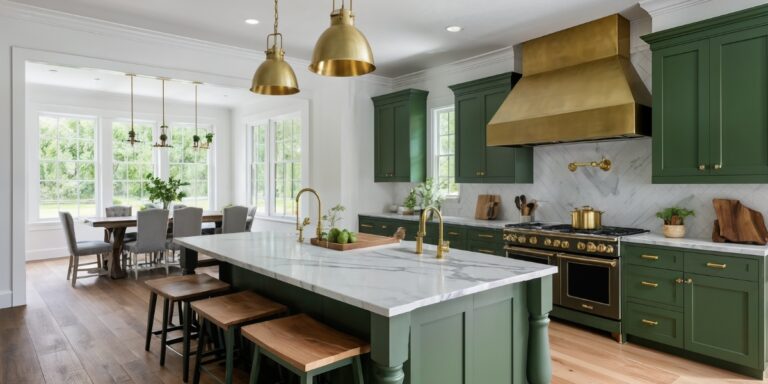In my experience working with homeowners on Scandinavian-inspired kitchen projects, I’ve observed that this design approach often creates remarkably peaceful and functional cooking environments. Through various cabin and Nordic-style projects, I’ve learned that Scandinavian kitchen design typically combines minimalist principles with natural materials while maintaining practical functionality that accommodates both daily cooking needs and entertaining.
Note: For any structural modifications, electrical work, plumbing, gas installations, or major kitchen renovations mentioned in this article, always consult with licensed professionals to ensure safety, proper ventilation, and code compliance.
What makes Scandinavian cabin kitchen design particularly appealing to many homeowners is its emphasis on creating calm, organized spaces that feel both sophisticated and approachable. I’ve found that people often choose this approach because it typically promotes efficient cooking workflows while maintaining the cozy, inviting atmosphere that defines Nordic living philosophy.
The key to successful Scandinavian cabin kitchen design often lies in balancing minimalist aesthetics with practical storage needs and incorporating natural materials that age gracefully. Effective Nordic-inspired kitchens typically embrace light colors, quality materials, and streamlined organization while incorporating elements that create warmth and prevent spaces from feeling sterile.
Here are 21 approaches for Scandinavian cabin kitchens that often work well in different settings, based on observations from various Nordic-inspired design projects.
1. Light Color Foundation Strategy
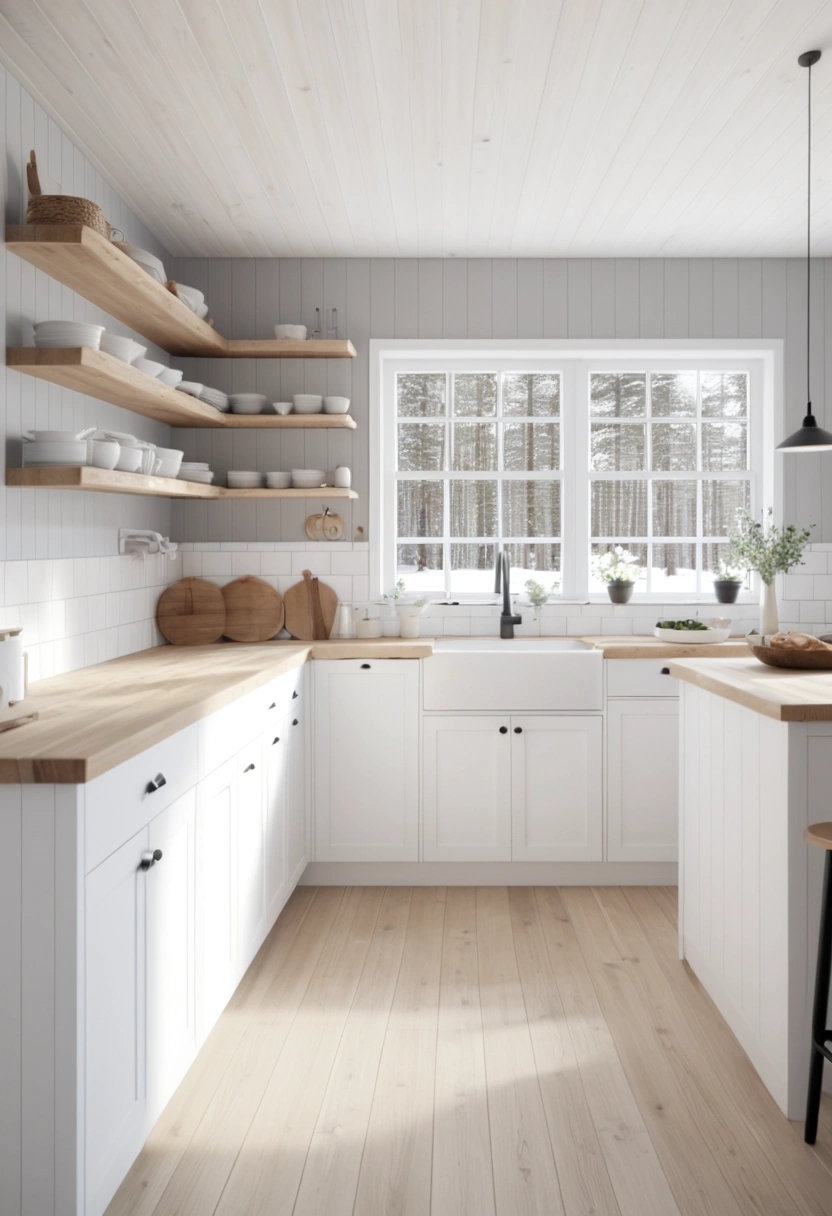
This color approach often appeals to homeowners seeking to maximize natural light and create spacious feelings. Light neutral palettes typically reflect available light while providing versatile backgrounds that accommodate various accent elements and seasonal changes.
Design consideration: Light colors often require careful attention to texture and material variation to prevent spaces from appearing flat while their reflective qualities can enhance both natural and artificial lighting.
Practical benefit: Neutral foundations typically hide minor wear better than bold colors while providing flexibility to adjust accent elements as preferences change over time.
2. Natural Wood Integration
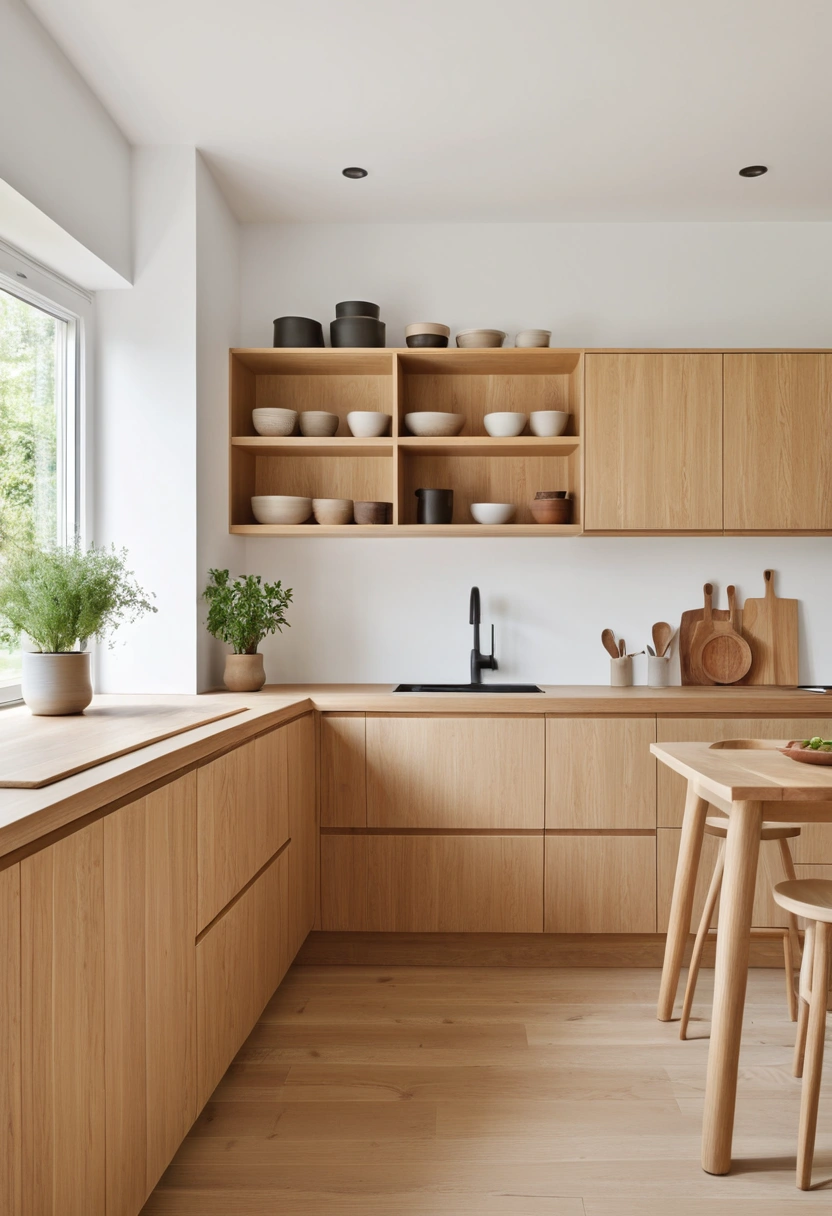
This material approach often appeals to those wanting authentic, organic character. Light wood species typically provide necessary warmth while offering the durability needed for kitchen environments exposed to moisture and daily use.
Design consideration: Wood selections often require consideration of moisture resistance while their natural variation provides visual interest that prevents uniformity from becoming monotonous.
Practical benefit: Quality wood surfaces typically develop beautiful patina over time while offering natural antimicrobial properties that enhance kitchen hygiene when properly maintained.
3. Minimalist Organization Systems
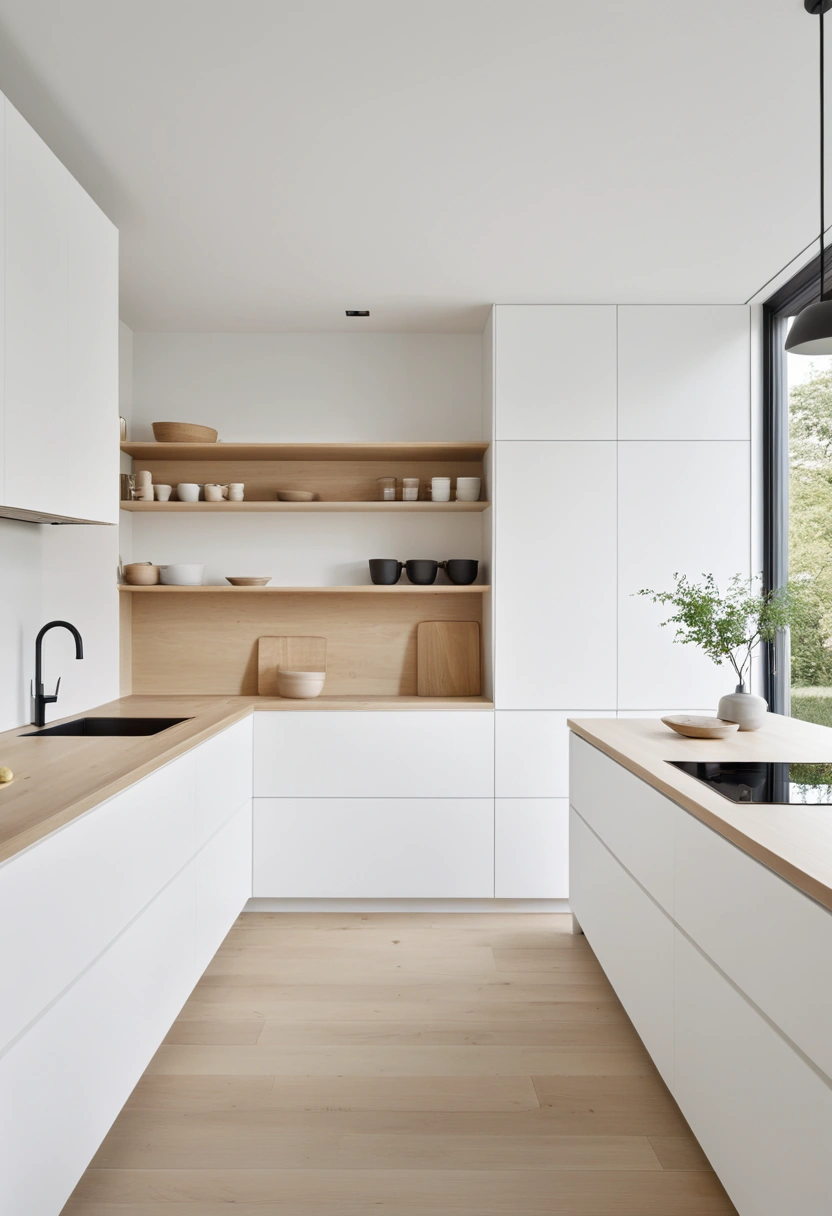
This storage approach often appeals to homeowners prioritizing efficiency and visual calm. Streamlined storage solutions typically maintain clean aesthetics while accommodating all necessary kitchen items and equipment.
Design consideration: Minimalist systems often require careful planning to ensure adequate storage while their hidden nature demands well-organized internal arrangements for practical daily use.
Practical benefit: Integrated storage typically reduces visual clutter while improving cooking efficiency through organized, accessible placement of frequently used items.
4. Strategic Contrast Elements
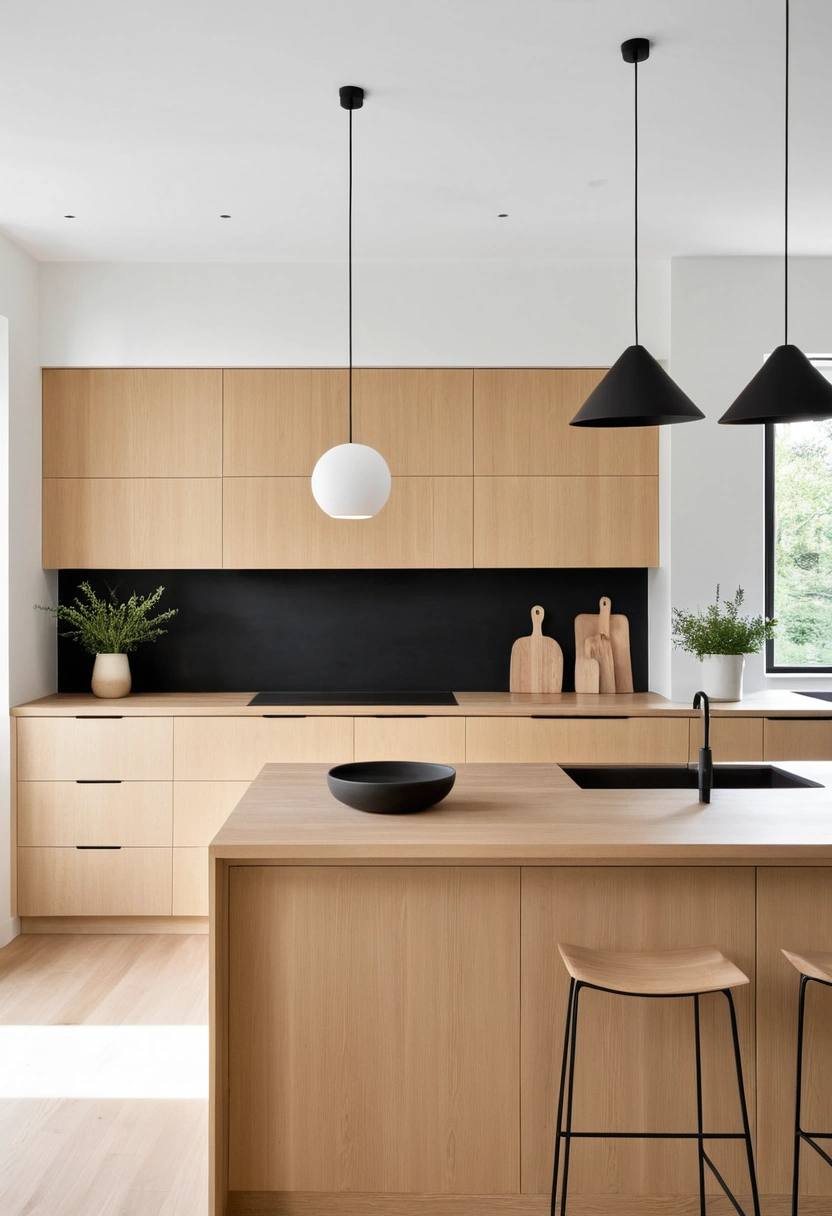
This visual approach often appeals to those wanting sophisticated depth without overwhelming simplicity. Dark accent elements typically provide necessary visual anchors while maintaining the clean aesthetic characteristic of Scandinavian design.
Design consideration: Contrast elements often work best when used sparingly while their placement should enhance rather than compete with natural materials and architectural features.
Practical benefit: Dark finishes typically hide wear and fingerprints better than light alternatives while providing timeless contrast that doesn’t quickly become outdated.
5. Open Display Solutions
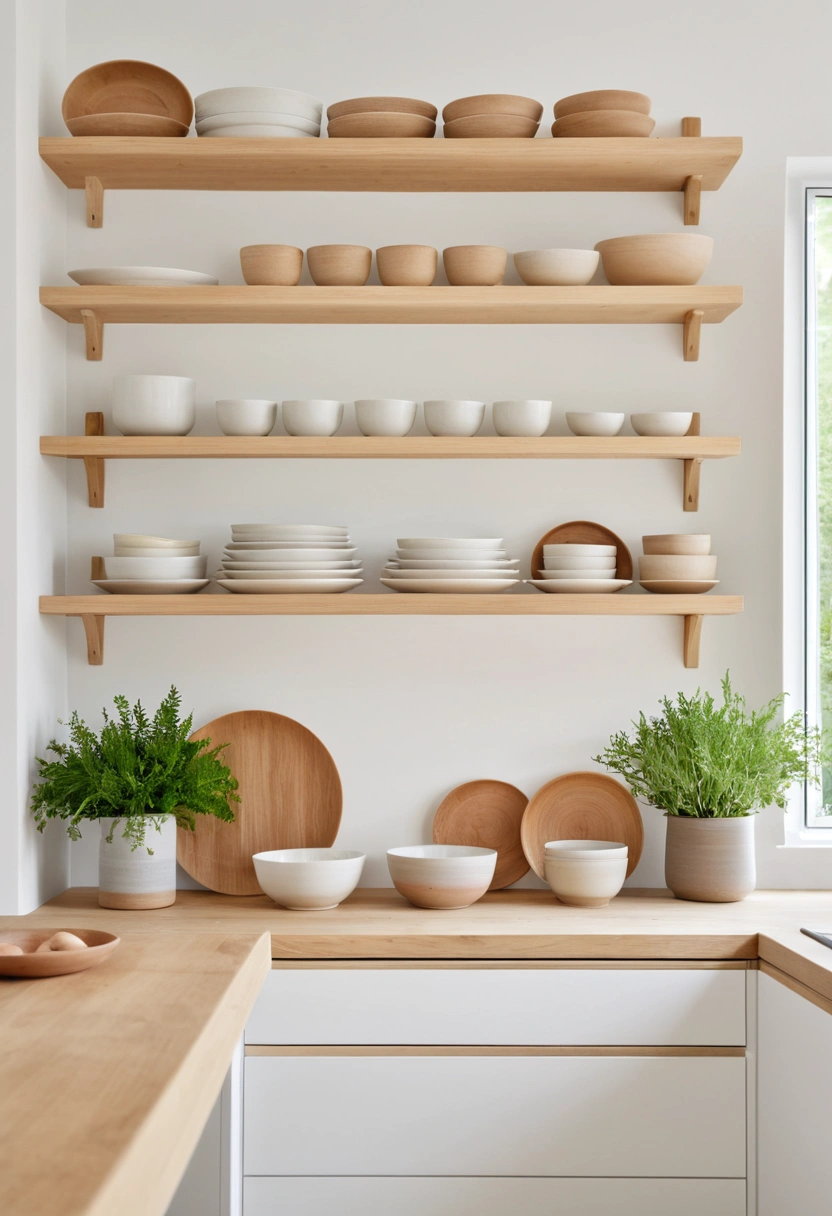
This storage approach often appeals to homeowners wanting both functionality and visual interest. Open shelving typically provides accessible storage while creating opportunities to display beautiful everyday items and seasonal elements.
Design consideration: Open storage often requires careful curation while their visible nature demands consistent organization and attractive storage containers to maintain aesthetic appeal.
Practical benefit: Accessible shelving typically improves cooking efficiency while providing flexibility to adjust displays seasonally or as collections change over time.
6. Functional Lighting Design
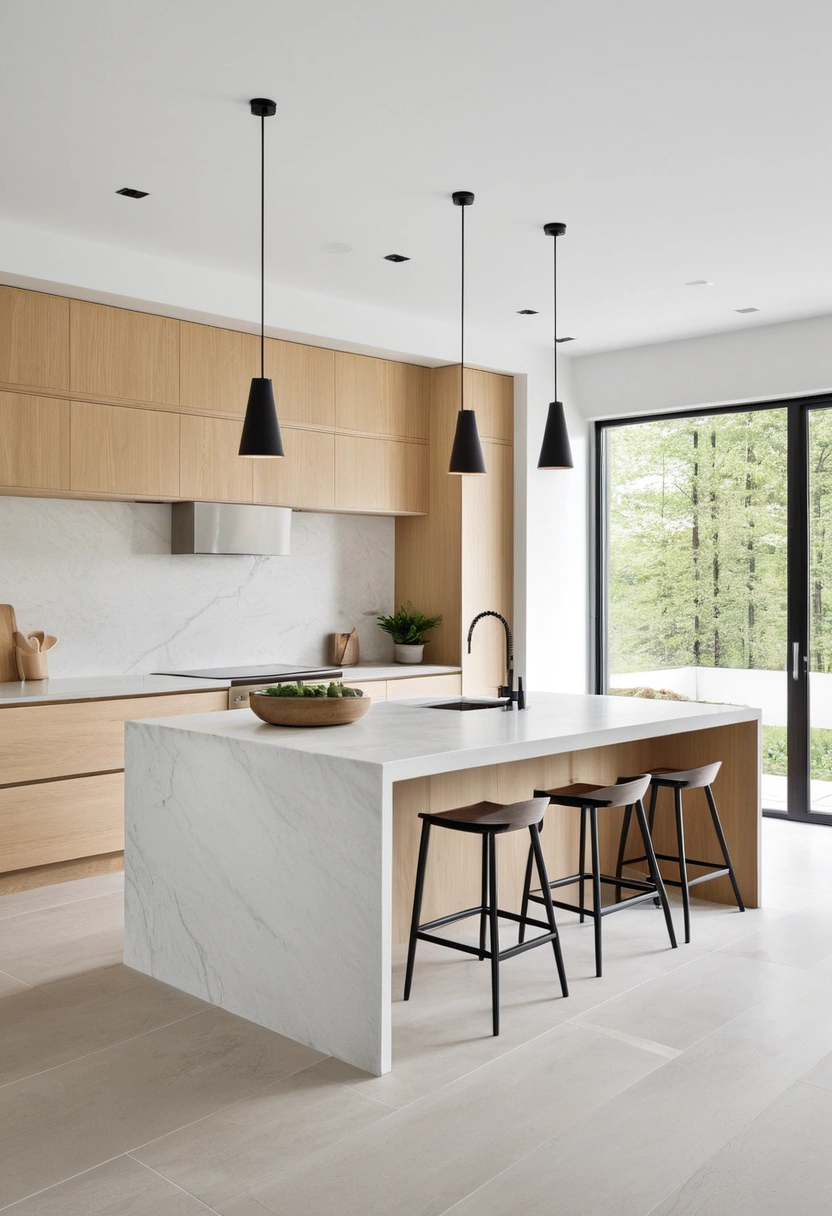
This illumination approach often appeals to those wanting both task functionality and ambient atmosphere. Clean-lined fixtures typically provide necessary work lighting while contributing to the overall minimalist aesthetic.
Design consideration: Kitchen lighting often requires layered approaches while fixture selection should complement rather than compete with other design elements and natural light sources.
Practical benefit: Quality lighting typically improves cooking safety while creating inviting atmospheres that enhance both daily use and entertaining experiences.
7. Efficient Layout Planning
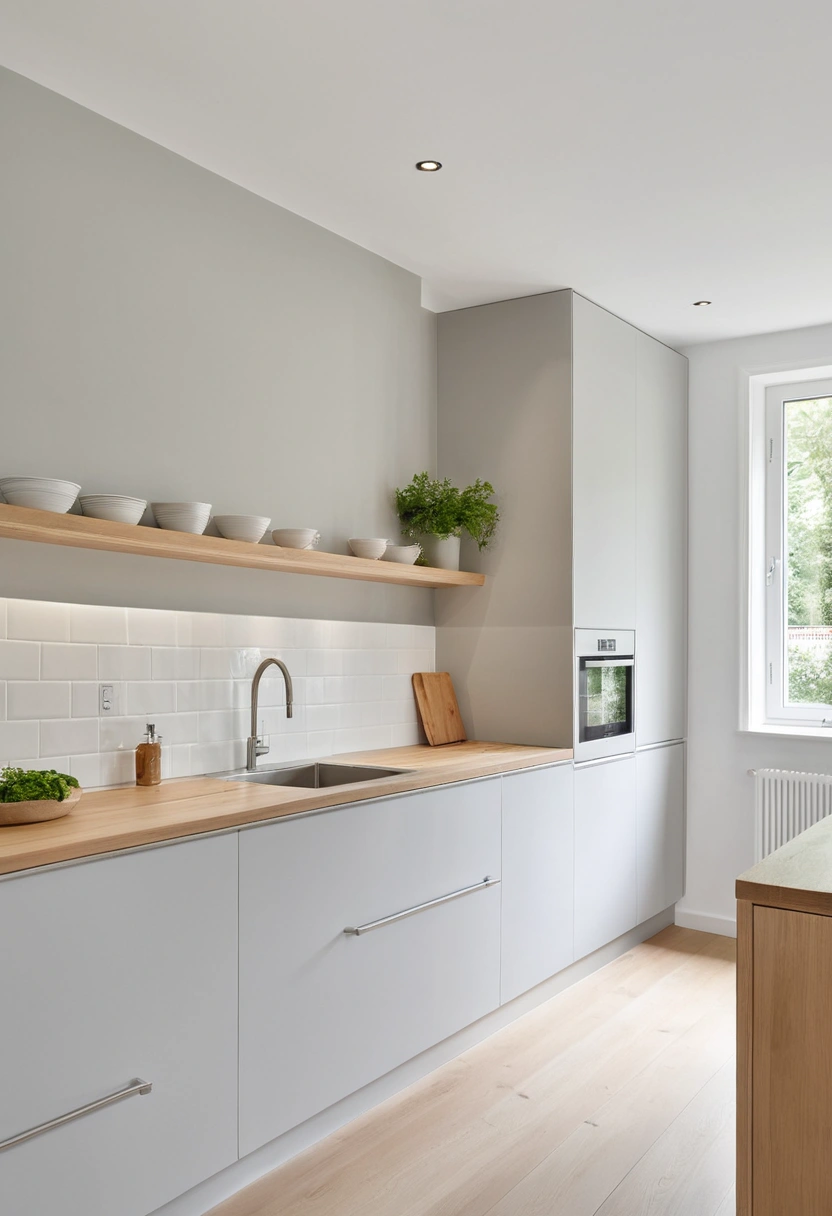
This spatial approach often appeals to homeowners wanting maximum functionality from available space. Work triangle principles typically improve cooking efficiency while thoughtful traffic flow enhances both daily use and entertaining.
Design consideration: Layout efficiency often requires careful appliance placement while traffic patterns should accommodate multiple users during busy cooking and entertaining periods.
Practical benefit: Optimized layouts typically reduce cooking time while improving safety through logical placement of heat sources, water access, and storage areas.
8. Durable Surface Materials
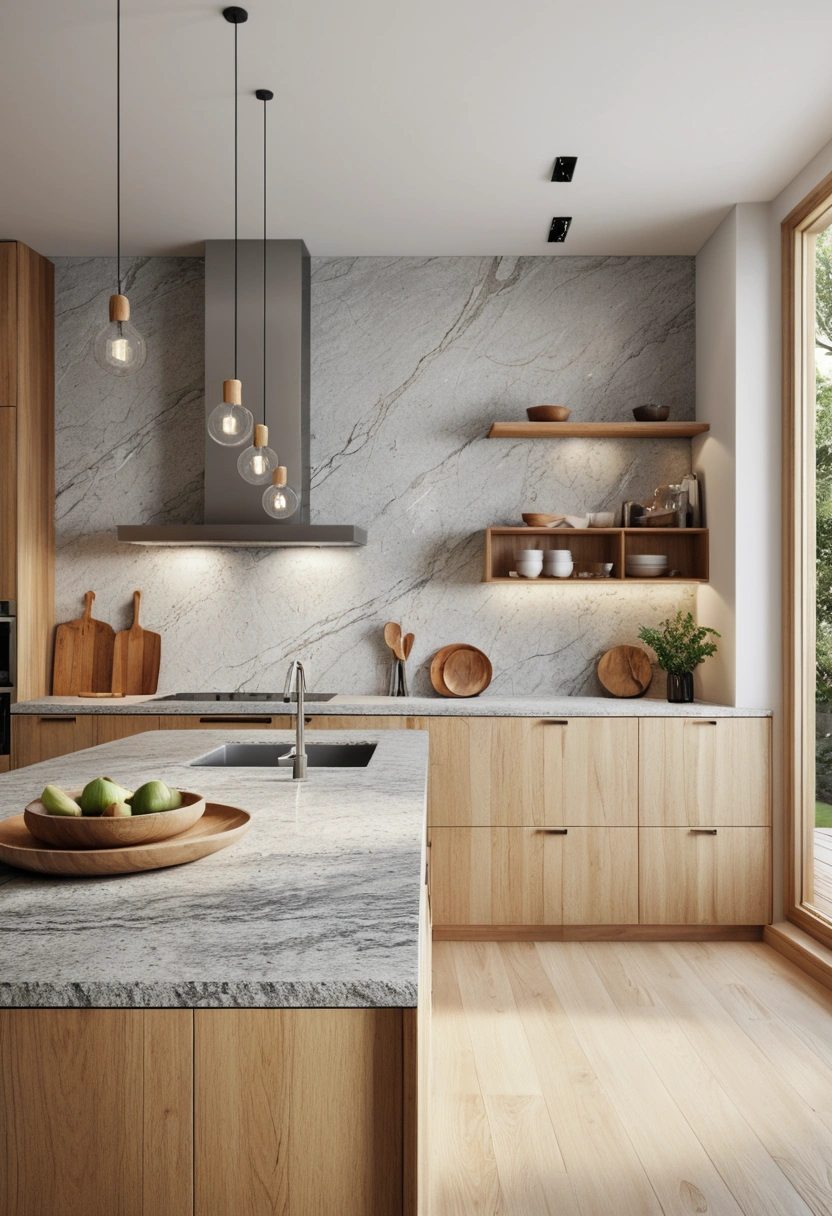
This practical approach often appeals to those wanting both beauty and longevity. Natural stone surfaces typically provide excellent durability while offering the sophisticated appearance that enhances property value.
Design consideration: Stone selections often require consideration of maintenance needs while their natural variation provides unique character that distinguishes each installation.
Practical benefit: Quality stone surfaces typically withstand heavy use while offering heat resistance and easy maintenance that supports busy kitchen lifestyles.
9. Textile Comfort Elements
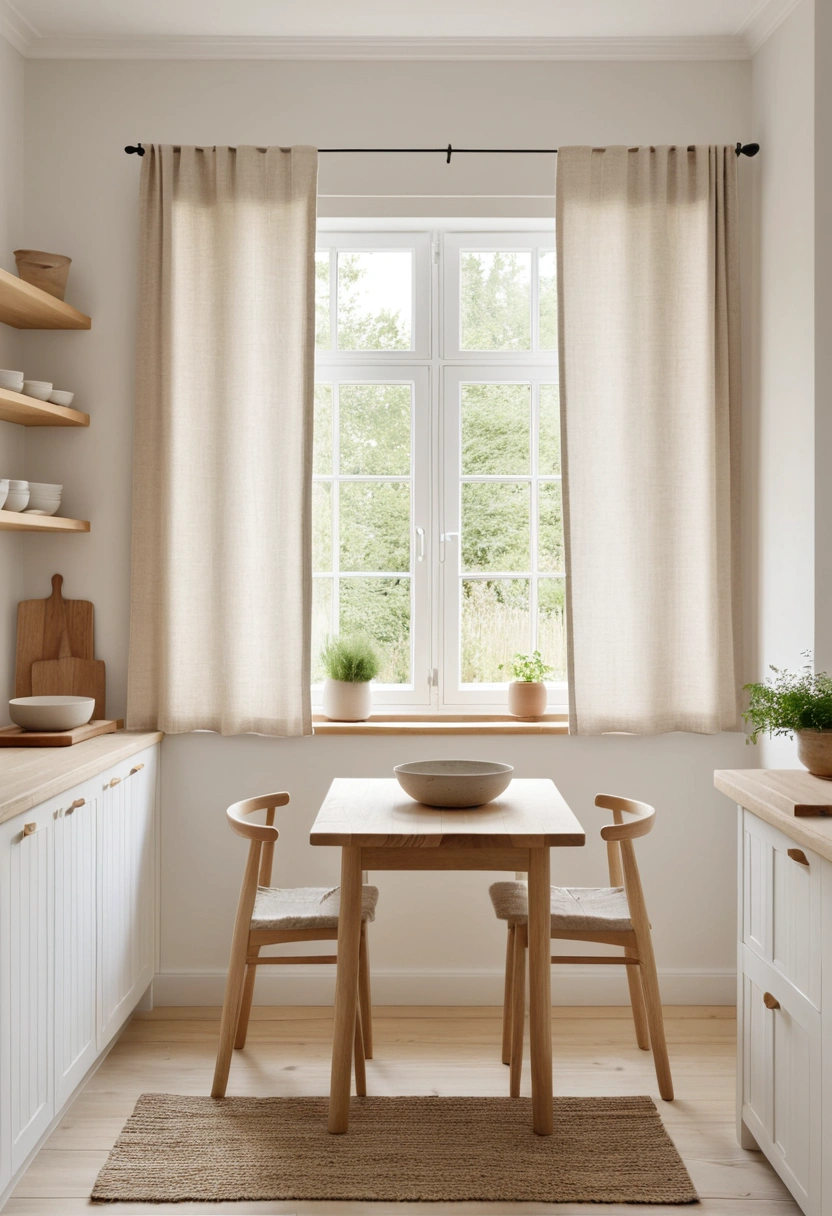
This softening approach often appeals to homeowners wanting to balance hard surfaces with comfort elements. Natural fiber textiles typically provide necessary warmth while maintaining the organic aesthetic characteristic of Scandinavian design.
Design consideration: Kitchen textiles often require frequent cleaning while their placement should enhance comfort without interfering with cooking safety or efficiency.
Practical benefit: Quality natural textiles typically offer good durability while providing opportunities for seasonal updates that refresh room atmosphere affordably.
10. Living Plant Integration
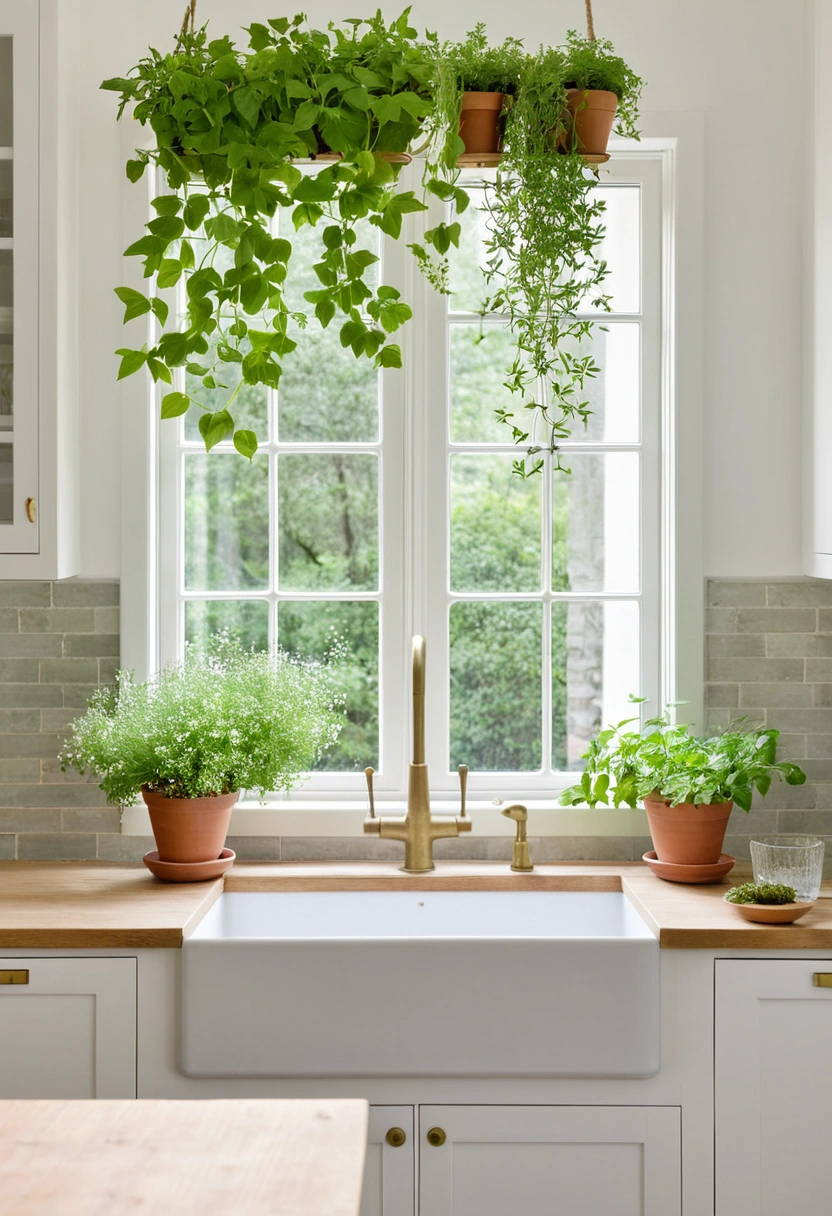
This biophilic approach often appeals to those wanting to connect indoor spaces with natural environments. Carefully selected plants typically enhance air quality while providing fresh ingredients and natural beauty.
Design consideration: Kitchen plants often require consideration of cooking heat and humidity while their placement should enhance rather than interfere with food preparation activities.
Practical benefit: Edible plants typically provide fresh ingredients while contributing to improved indoor air quality and natural beauty that enhances daily cooking experiences.
11. Traditional Sink Solutions
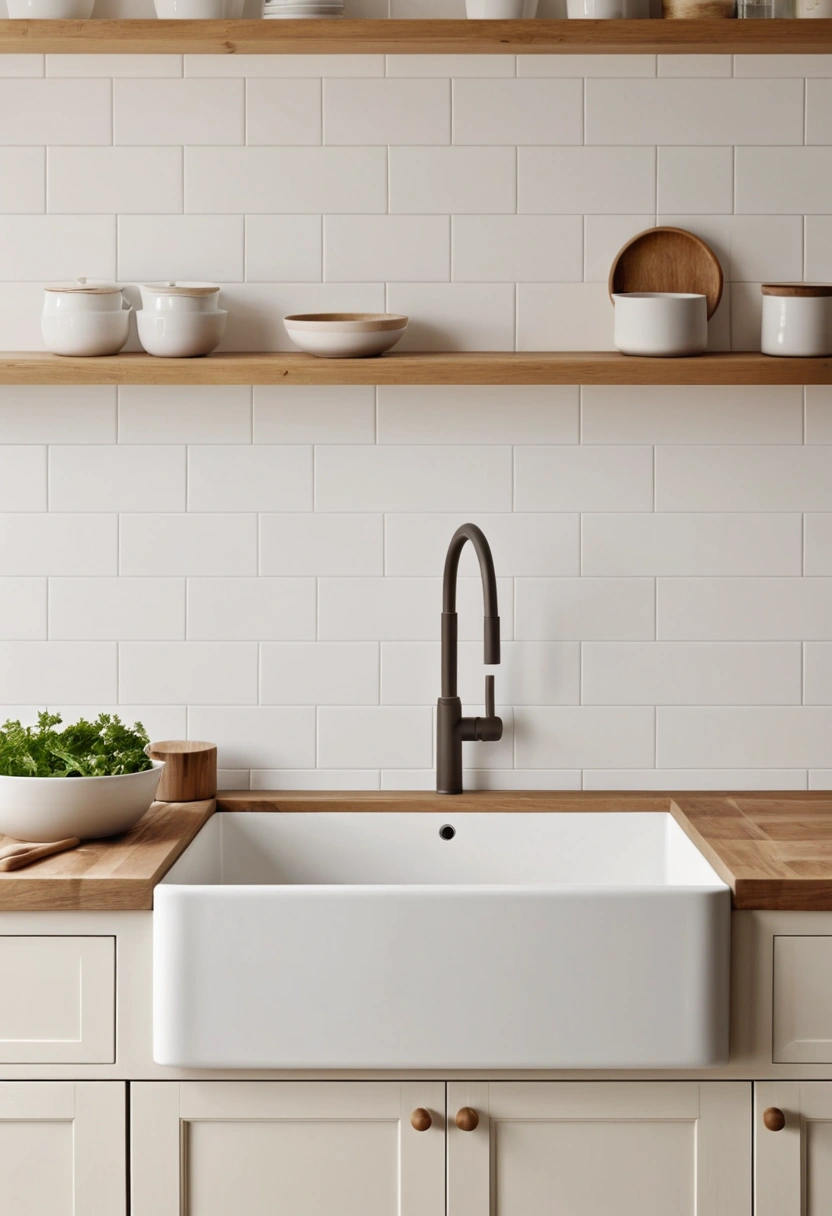
This functional approach often appeals to homeowners wanting both practicality and authentic character. Deep basin sinks typically accommodate large cooking projects while providing the rustic character that enhances cabin authenticity.
Design consideration: Large sinks often require adequate cabinet support while their prominent placement makes them natural focal points that should coordinate with overall design themes.
Practical benefit: Generous sink capacity typically improves cooking efficiency while durable materials provide longevity that justifies the investment in quality fixtures.
12. Integrated Appliance Systems
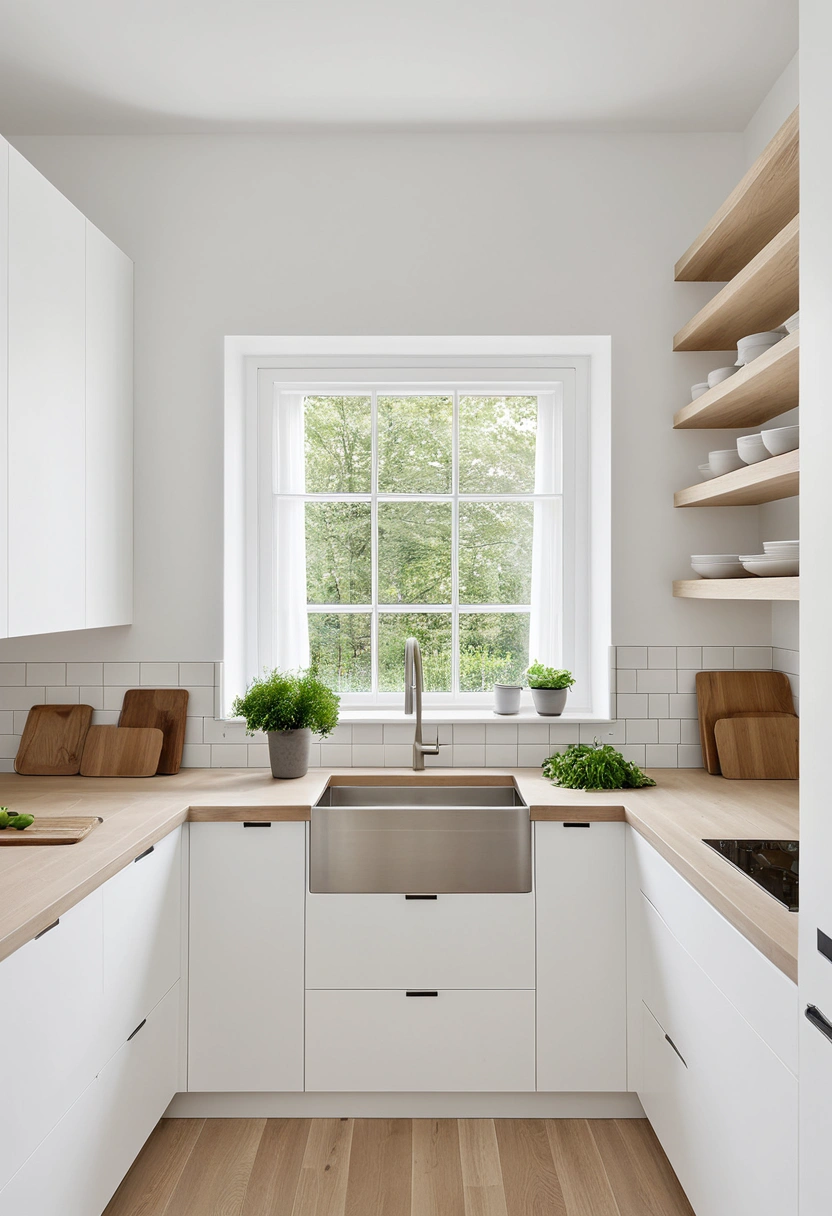
This streamlined approach often appeals to those wanting cohesive, uncluttered appearances. Panel-ready appliances typically maintain visual consistency while providing modern functionality and energy efficiency.
Design consideration: Integrated appliances often require precise planning while their hidden nature can create challenges for service access and daily operation indicators.
Practical benefit: Seamless integration typically enhances resale value while reducing visual disruption that can make smaller kitchens feel cluttered or commercial.
13. Sustainable Material Choices
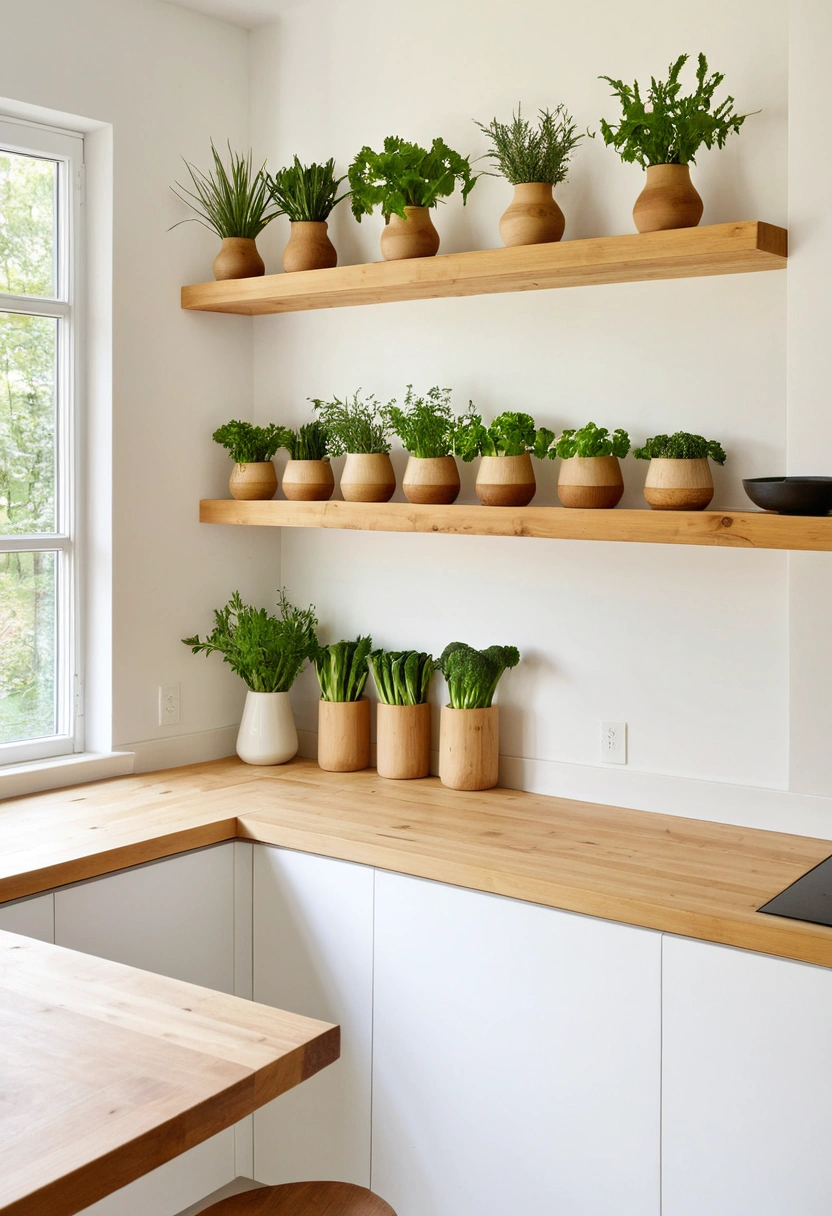
This environmental approach often appeals to homeowners wanting responsible, health-conscious selections. Eco-friendly materials typically provide superior indoor air quality while supporting sustainable manufacturing practices.
Design consideration: Sustainable materials often require research to verify claims while their performance characteristics should meet practical kitchen demands for durability and maintenance.
Practical benefit: Environmental choices typically offer improved health benefits while supporting responsible manufacturing that aligns with Nordic values of environmental stewardship.
14. Casual Dining Integration
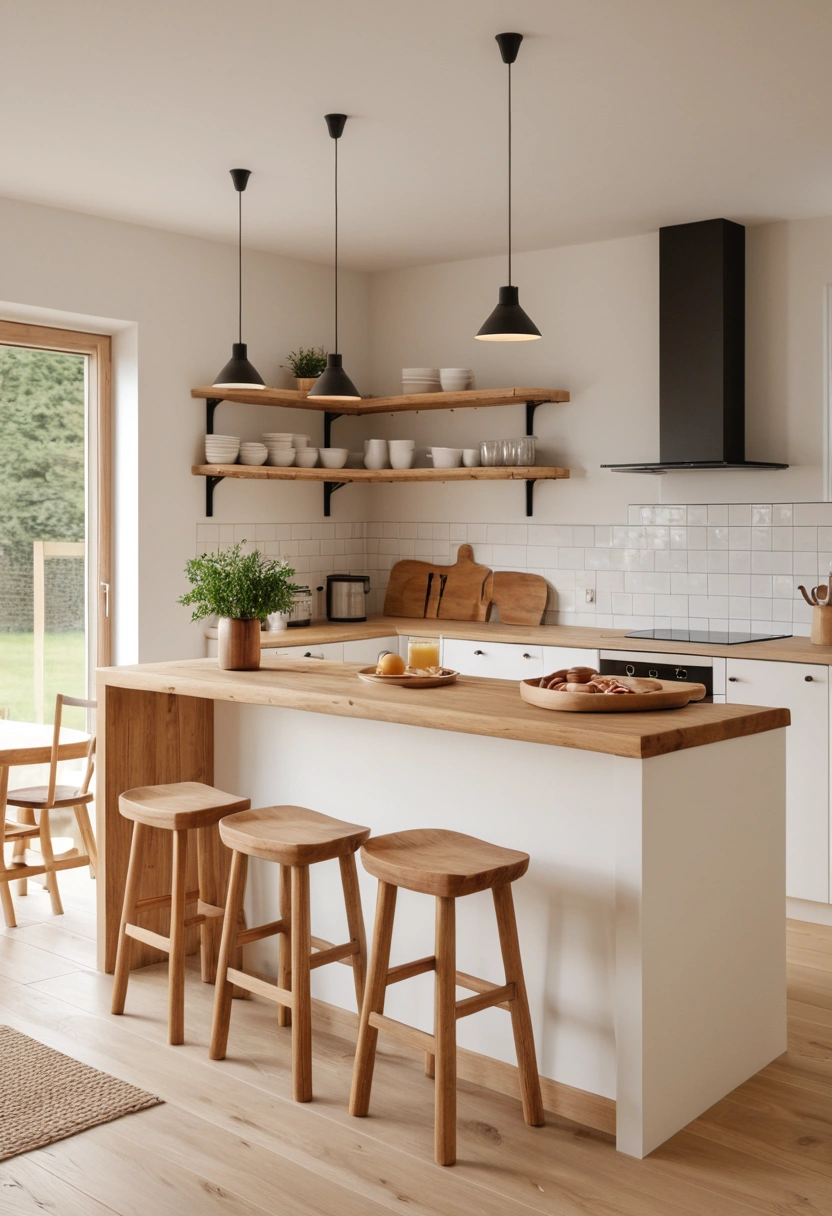
This social approach often appeals to families wanting informal gathering spaces within kitchen areas. Counter seating typically provides convenient dining while creating natural conversation areas during food preparation.
Design consideration: Counter dining often requires adequate clearance while seating height should coordinate with work surface dimensions for comfort and proportional appearance.
Practical benefit: Integrated dining typically maximizes space efficiency while providing flexible seating that accommodates both daily meals and casual entertaining.
15. Subtle Finish Selections
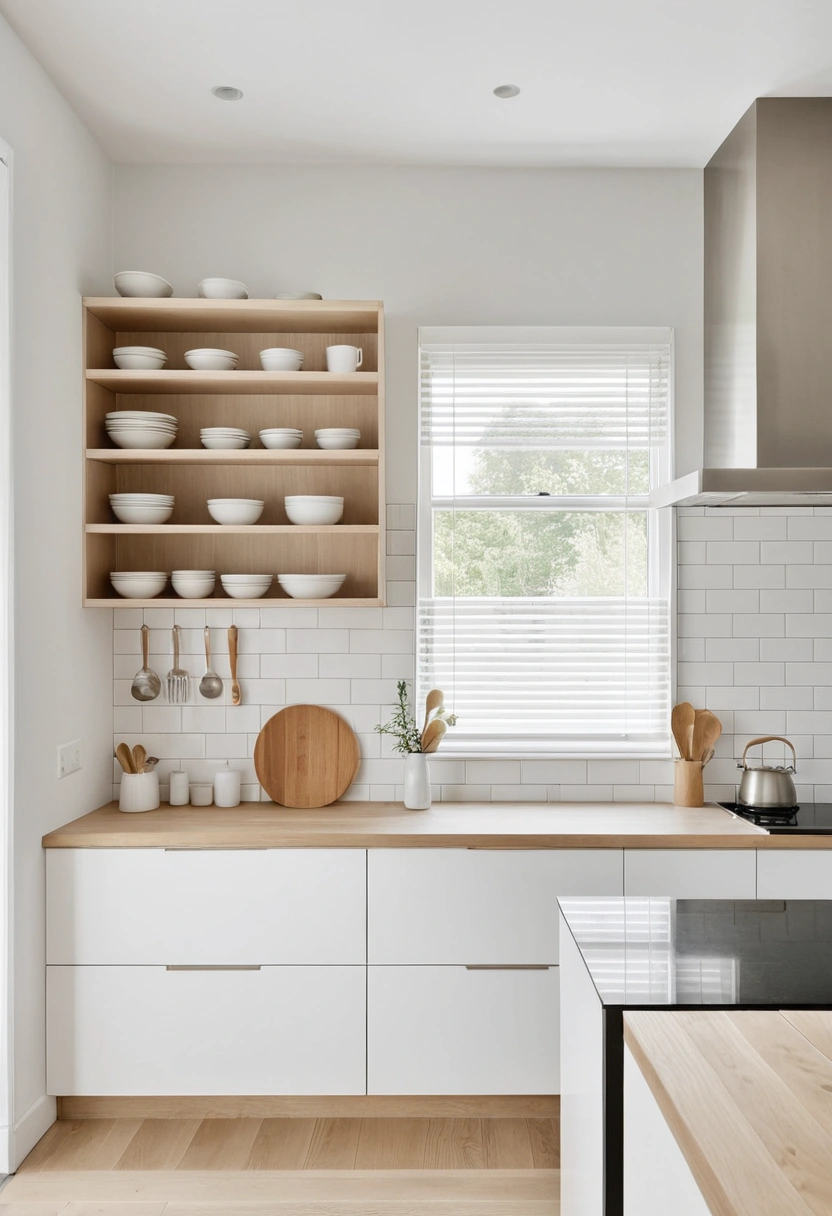
This aesthetic approach often appeals to those wanting sophisticated, low-maintenance surfaces. Matte finishes typically provide rich color depth while offering practical benefits for busy family kitchens.
Design consideration: Matte surfaces often show different wear patterns while their non-reflective quality can enhance the calm atmosphere characteristic of Scandinavian design.
Practical benefit: Low-gloss finishes typically hide fingerprints better than glossy alternatives while providing easier touch-up capabilities when minor wear occurs over time.
16. Mixed Material Harmony
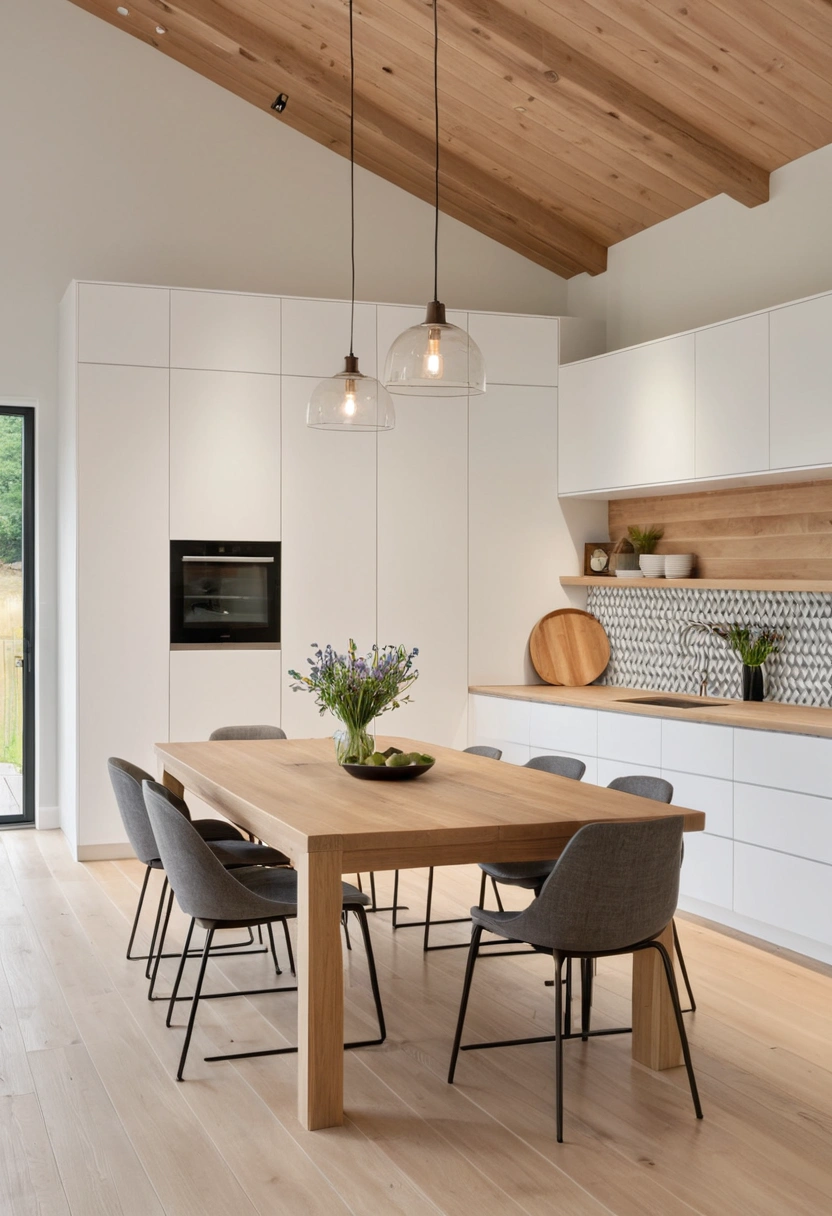
This textural approach often appeals to homeowners wanting visual interest without overwhelming complexity. Balanced combinations typically provide necessary contrast while maintaining the cohesive aesthetic essential to Nordic design.
Design consideration: Material mixing often requires careful proportion planning while contrasting elements should enhance rather than compete with primary design themes.
Practical benefit: Varied materials typically distribute wear patterns while providing different functional benefits like heat resistance, moisture protection, and structural support.
17. Heating Element Integration
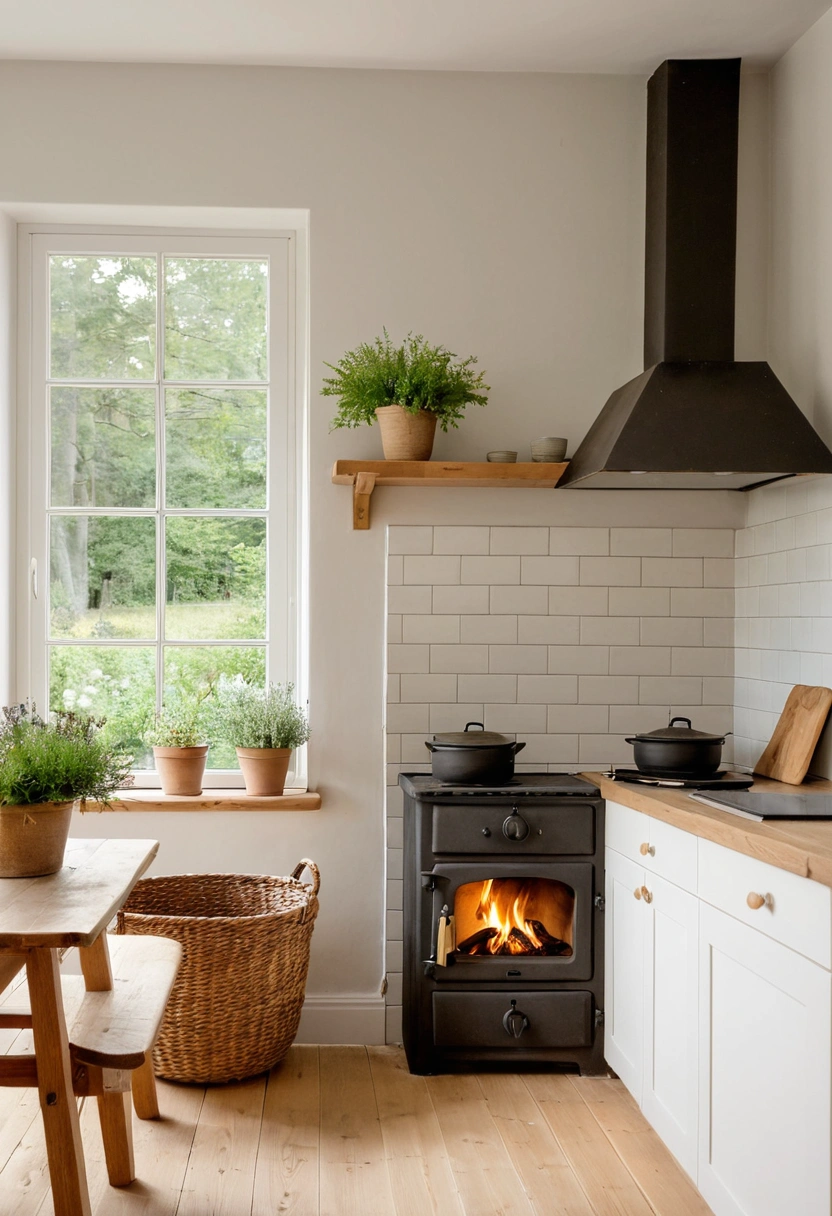
This comfort approach often appeals to those in cold climates wanting both warmth and atmosphere. Compact heating systems typically provide supplemental warmth while creating focal points that enhance cozy cabin character.
Design consideration: Heating elements often require proper ventilation and clearances while their placement should enhance rather than interfere with kitchen workflow and safety.
Practical benefit: Auxiliary heating typically reduces energy costs while providing atmospheric warmth that enhances kitchen comfort during extended cooking and entertaining periods.
18. Thoughtful Art Selection
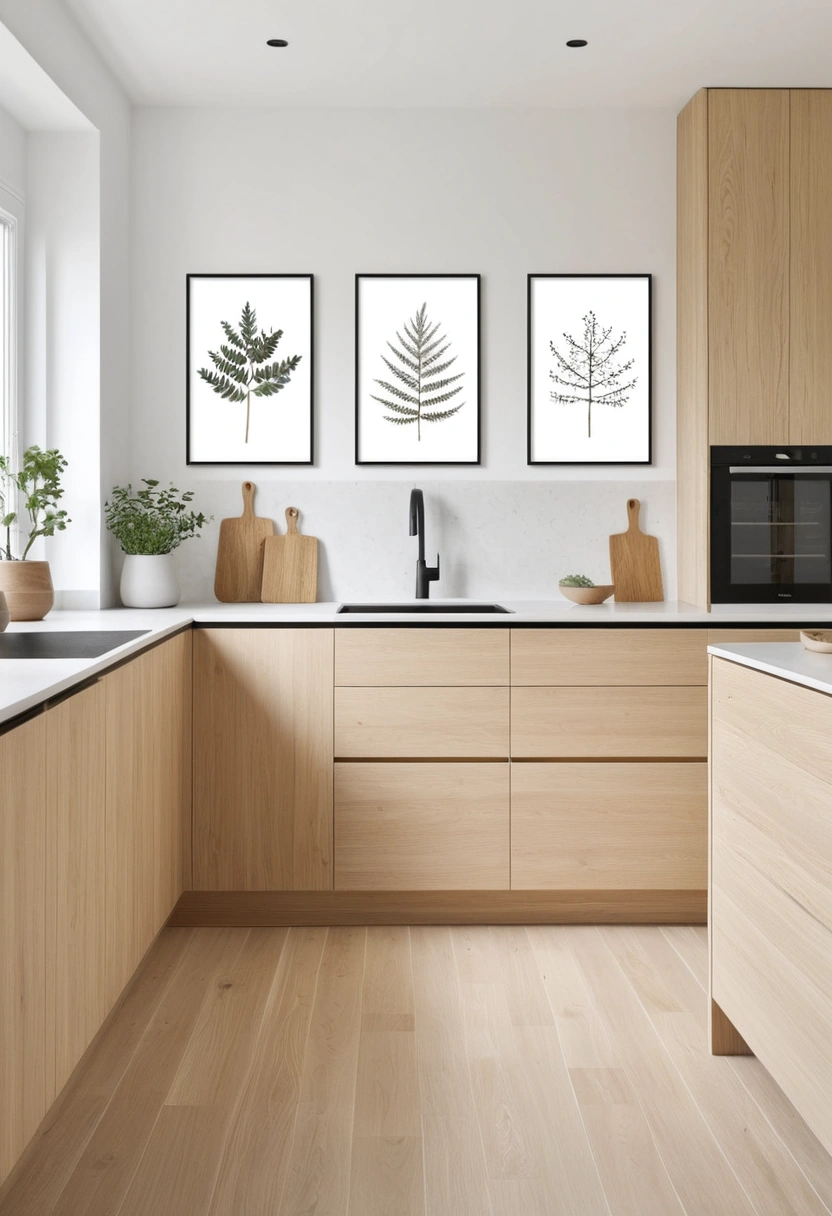
This personality approach often appeals to homeowners wanting to add character without overwhelming minimalist aesthetics. Simple, nature-inspired artwork typically provides visual interest while maintaining the calm atmosphere essential to Nordic design.
Design consideration: Kitchen art often requires consideration of moisture and heat exposure while selections should complement rather than compete with functional elements.
Practical benefit: Quality artwork typically enhances daily enjoyment while providing opportunities for personal expression within the disciplined framework of Scandinavian aesthetics.
19. Subtle Pattern Applications
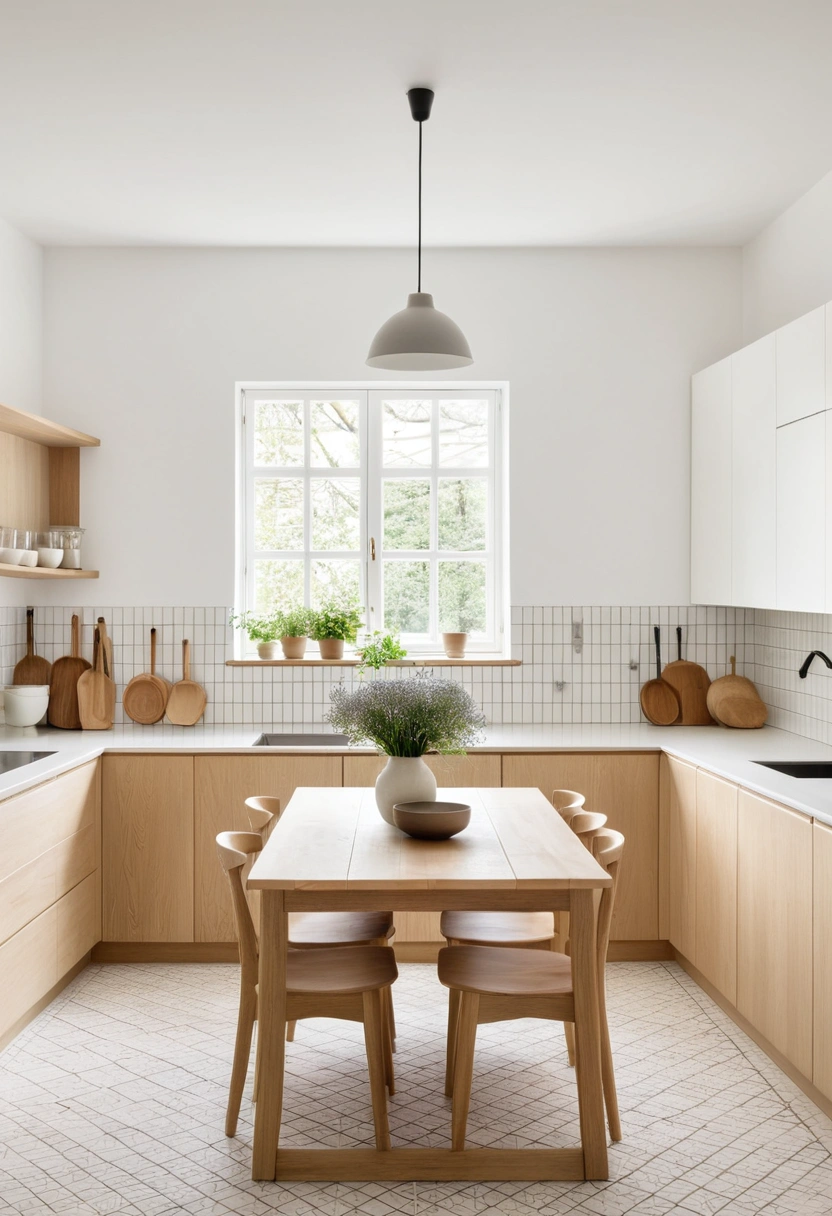
This visual approach often appeals to those wanting texture and interest without bold statements. Gentle geometric patterns typically add depth while maintaining the understated character characteristic of Nordic design.
Design consideration: Pattern applications often work best in limited quantities while their scale should complement rather than overwhelm room proportions and other design elements.
Practical benefit: Textured surfaces typically hide minor wear better than smooth alternatives while providing visual interest that prevents minimalist spaces from appearing sterile.
20. Natural Wall Treatment Options
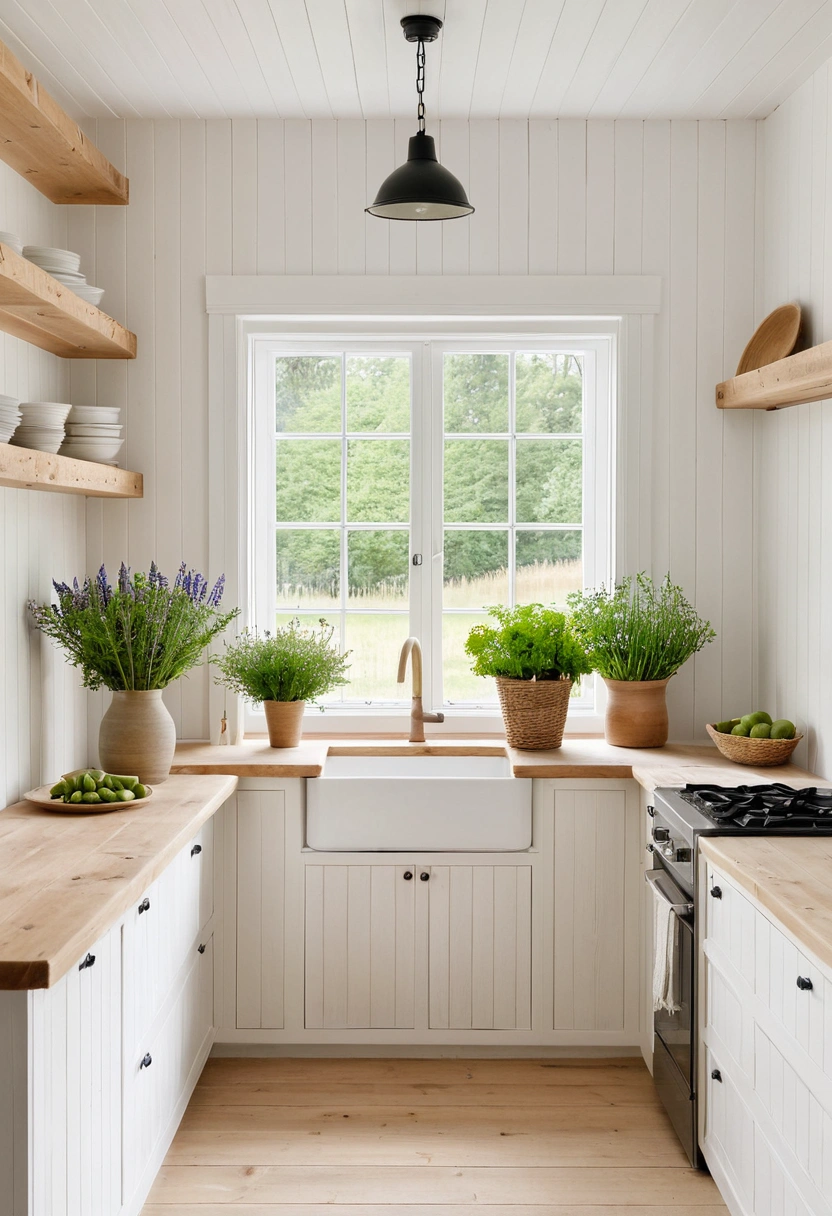
This architectural approach often appeals to homeowners wanting authentic cabin character. Wood wall treatments typically provide necessary texture while honoring traditional construction methods and materials.
Design consideration: Wall treatments often require consideration of moisture resistance while their installation should enhance rather than conflict with modern kitchen requirements.
Practical benefit: Natural wall materials typically age gracefully while providing insulation benefits and acoustic absorption that enhance kitchen comfort and functionality.
21. Ambient Atmosphere Creation
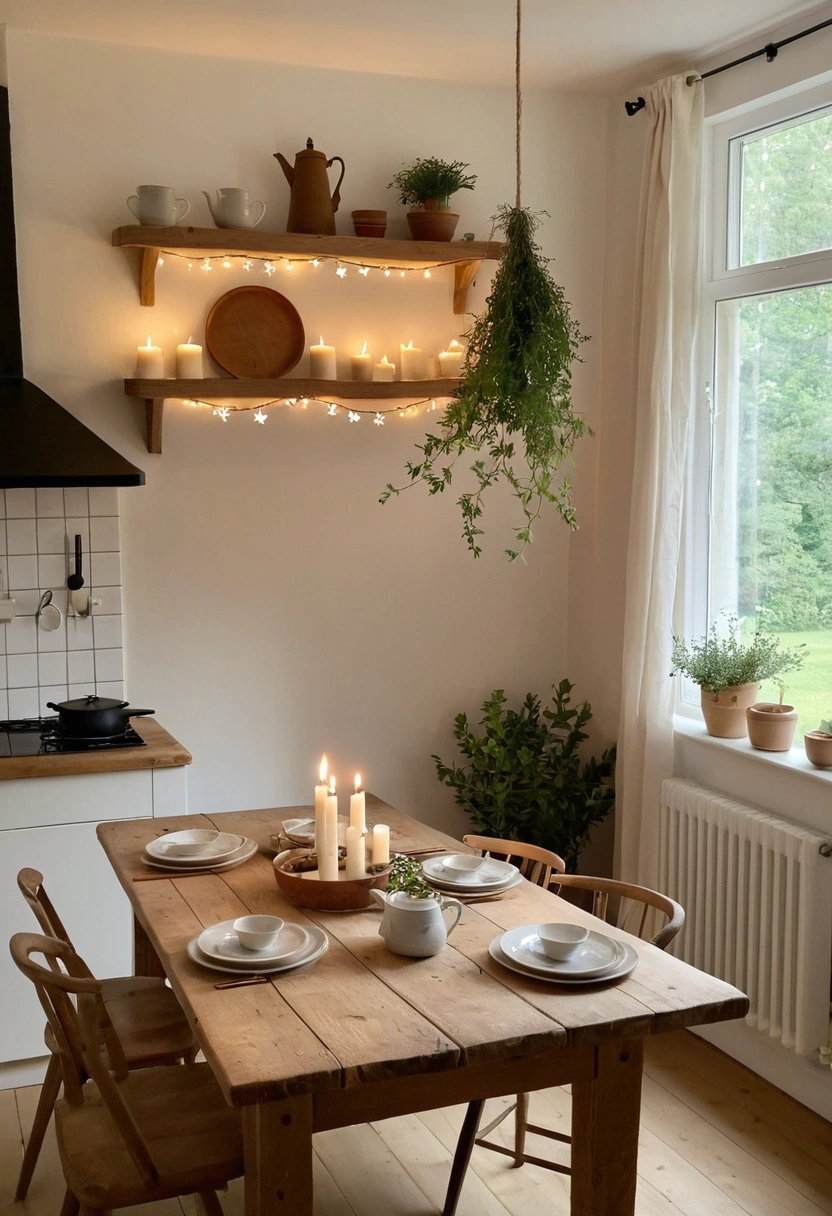
This comfort approach often appeals to those wanting to enhance the cozy character that defines Nordic living. Warm lighting elements typically create inviting atmospheres while supporting the concept of hygge that makes spaces genuinely livable.
Design consideration: Atmospheric lighting often requires layered approaches while safety considerations should guide placement near cooking areas and high-moisture zones.
Practical benefit: Varied lighting options typically enhance both daily functionality and entertaining atmosphere while providing energy-efficient alternatives that reduce utility costs.
Creating Your Scandinavian Cabin Kitchen
Through various Nordic-inspired kitchen projects, I’ve observed that successful Scandinavian cabin kitchens often balance minimalist aesthetics with practical functionality while incorporating natural materials that create warmth and character. These spaces typically succeed because they prioritize both efficiency and comfort while maintaining the clean, organized aesthetic that defines Nordic design philosophy.
The Scandinavian approach often works well for cabin kitchens because it typically creates environments that feel both sophisticated and genuinely livable. Effective implementation usually involves careful planning of storage systems, selection of appropriate materials for cabin environments, and integration of lighting that supports both cooking tasks and cozy atmosphere.
Planning considerations often include assessing available natural light throughout seasons, ventilation requirements for cabin environments, and budget allocation between quality materials and functional systems. Many successful projects prioritize key elements like efficient layout and quality appliances while finding cost-effective ways to incorporate natural materials and lighting that enhance the overall Nordic character.
Remember: For any gas installations, electrical work, plumbing modifications, structural changes, or ventilation systems related to cabin kitchen construction, always consult with licensed professionals to ensure proper installation, adequate ventilation, and compliance with local building codes and safety regulations.

